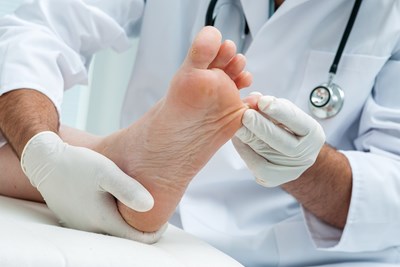Onychomycosis is the technical term for toenail fungus. These microscopic organisms prosper in warm, moist environments and can be picked up through a crack in the nail, small cuts, or a when the nail becomes separated from the skin. Although it may not show symptoms for some time, when it does, the nail may become thick, discolored, or flaky. Careful choice of footwear and diligent hygiene can help prevent picking up one of the four types of onychomycosis.
Distal Subungual Onychomycosis
Dermatophytes are the most common fungus to cause infection in the toenails. This fungus is also responsible for athlete’s foot, a between-the-toes infection. It starts in the nail and nail bed, turning the nail itself white or yellow. As the infection progresses, bits of nail and skin collect underneath, which increases the discoloration and makes the nail thick and difficult to trim. As it gets worse, the nail will crack, crumble, and separate from the skin.
Although there are many simple at-home and prescription treatments, it may take a long time to combat the infection. Recurrences are also quite prevalent. It’s extremely important to treat any shoes worn before or during the infection, as it can take years for symptoms to become obvious. As shoes often become sweaty, this creates an ideal breeding ground for the dermatophytes.
White Superficial Onychomycosis
While this is the second most common type of toenail fungal infection, it only makes up about 10% of infections. Rather than infecting the entirety of the nail, a proximal subungual infection is usually only visible on top of the nail. White spots form, growing and spreading until the entire surface is crumbly and soft, with a chalky layer of powdered substance across it. Diagnosis is made by scraping off a part of the toenail for examination.
Luckily, this particular infection is very easy to treat. Because it stays on the surface initially, topical treatments may be very effective. However, it will eventually invade the nail bed, and so oral antifungals may be necessary.
Candida Onychomycosis
Candida is the organism responsible for yeast infections. Although uncommon, it can occur in the toenails and often affects multiple nails at once. Additionally, it can spread quite easily to the skin and may infect the surrounding area. The nail bed and nail separate, and the nail itself may become white, green, or brown. It causes pain more often than other types of onychomycosis, especially because of the inflammation of the skin in the area surrounding the infection. It occurs more frequently in people whose nails have already been infected or those who have some sort of wound.
Proximal Subungual Onychomycosis
Dermatophytes are also responsible for this particular infection, but it is much less common.The infection enters at the cuticle, turning it thick and separating it from the nail. While the nail base turns white, the rest of the nail becomes opaque. Skin all over the foot is also susceptible. It affects those with HIV more frequently than others because their immune systems are not functioning at normal capacity.



